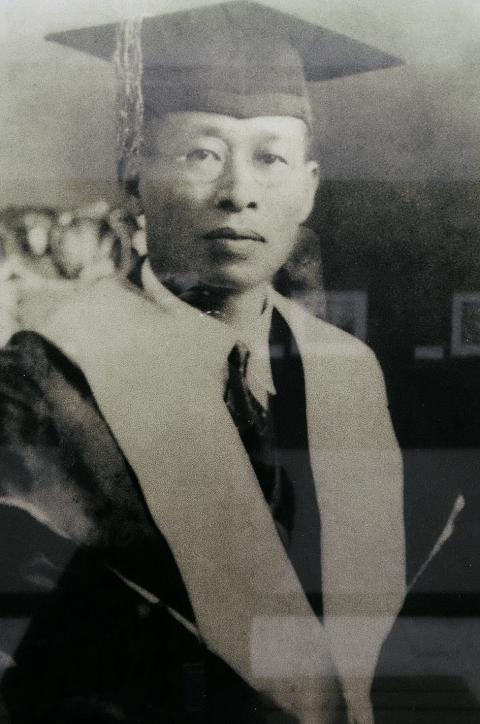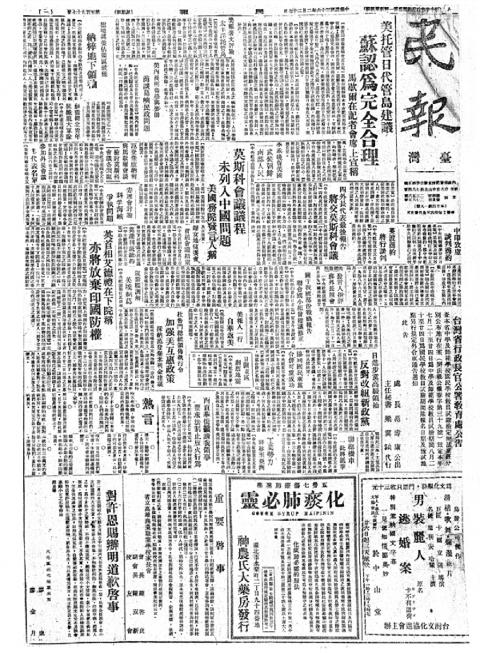Taiwan in Time: Feb. 22 to Feb. 28
On the evening of March 11, 1947, as Chinese Nationalist Party (KMT) reinforcements from China clashed with local protesters throughout Taiwan, Lin Mo-seng (林茂生), founder of the Minpao (民報) newspaper and dean of liberal arts at National Taiwan University, was reportedly escorted from his family home by six men, never to be heard from again.
As the first Taiwanese to receive a Doctor of Philosophy degree, Lin was one of many intellectuals targeted by the China-based KMT government during its violent suppression following the 228 Incident, which began as an armed local uprising. A large number of Taiwan’s private newspapers, which sprung up after Japan’s surrender in August 1945, were shut down within two weeks of the initial incident, including Lin’s Minpao.

Photo: Meng Ching-tsu, Taipei Times
Not to be confused with the Japanese-era Taiwan Minpao (台灣民報), Lin’s paper made its debut on Oct. 10, 1945. Never afraid to criticize the government and including a column for citizen voices, it quickly became the most widely read private paper.
A quick sample of editorials during its brief existence shows titles such as “Are the People of Taiwan Really Happy?,” clearly reflecting the rising tension between local inhabitants and the newcomers from China.
One editorial, printed on July 24, 1946, even goes as far as stating that government corruption and nepotism is a “bad habit from the motherland that is now being picked up by Taiwanese.” It is not too hard to see why he would have upset the KMT.

Photo courtesy of National Library of Public Information
Interestingly, no institution in Taiwan appears to possess any record of this newspaper past Feb. 28, 1947, even though most sources have it printing its last issue on March 8, three days before Lin’s arrest.
The only reports available during the incident in the National Central Library’s newspaper archives are from the Taiwan Shin Sheng Daily News (台灣新生報), which was the official publication of the Taiwan Provincial Government, and the KMT-run China Daily News (中華日報).
The book, Lin Mo-seng, Chen Hsin and Their Era (林茂生, 陳炘和他們的年代) details Lin’s final days, as told to author Lee Hsiao-feng (李筱峰) by Lin’s son, Lin Tsung-yi (林宗義).
The younger Lin recalls his father responding to the incident, saying “Taiwanese are ready to tell the Mainlanders that we have had enough of being treated as second-class citizens, and we have had enough of authoritarian rule and government corruption that has been going on since October 1945.”
But Lin also denounced the use of force against the government, warning that violence is an ineffective method that would lead to disastrous results.
“The key to our future is democracy and respectful relations between Taiwanese and Mainlanders. We [Minpao] still face a momentous task in front of us,” he adds.
On March 4, after meeting with the 228 Incident Resolution Committee, Lin lamented to his son that this uprising lacked clear leadership and organization and that it was going nowhere.
The next day, Lin’s Japanese friend warned him that he was in danger. Even though Lin didn’t overtly participate in the uprising, he and his newspaper’s influence in society already posed a threat to the KMT.
On March 8, Taiwan governor Chen Yi’s (陳儀) reinforcement troops landed in Keelung as the government rejected all 32 demands made by the resolution committee, and the crackdown became increasingly violent. Minpao’s office was destroyed that night.
Lin Tsung-yi was notified by a servant of his father’s arrest in the morning of March 11. When Lin Mo-seng’s wife asked the men where they were taking him, one of them reportedly replied, “We’re going to see Chen Yi.”
Official charges against Lin included plotting rebellion, encouraging [NTU] students to riot and attempting to use international interference to achieve Taiwanese independence.
Most historians agree that the real reason Lin was arrested was because of his newspaper’s criticism of the government. And it was not just Lin.
The publishers of other private newspapers, such as the People’s Herald’s (人民導報) Wang Tien-teng (王添?) and Ta Ming Pao’s (大明報) Ai Lu-sheng (艾璐生), were also taken away never to be seen again.
But the most curious part of this is that even Juan Chao-jih, (阮朝日), general manager of the government’s Shin Sheng Daily News, became a victim of this media purge, together with editor Wu Chin-lien (吳金鍊) and other staff members.
On March 25, the Shin Sheng Daily News announced its new general manager and editor-in-chief, who were high-ranking military and government officials.
What happened to these people and how the newspaper’s coverage changed under the new management will be examined in next week’s edition of “Taiwan in Time.”
Part II appears in next Sunday’s Taipei Times.
Taiwan in Time, a column about Taiwan’s history that is published every Sunday, spotlights important or interesting events around the nation that have anniversaries this week.

Oct. 27 to Nov. 2 Over a breakfast of soymilk and fried dough costing less than NT$400, seven officials and engineers agreed on a NT$400 million plan — unaware that it would mark the beginning of Taiwan’s semiconductor empire. It was a cold February morning in 1974. Gathered at the unassuming shop were Economics minister Sun Yun-hsuan (孫運璿), director-general of Transportation and Communications Kao Yu-shu (高玉樹), Industrial Technology Research Institute (ITRI) president Wang Chao-chen (王兆振), Telecommunications Laboratories director Kang Pao-huang (康寶煌), Executive Yuan secretary-general Fei Hua (費驊), director-general of Telecommunications Fang Hsien-chi (方賢齊) and Radio Corporation of America (RCA) Laboratories director Pan
The consensus on the Chinese Nationalist Party (KMT) chair race is that Cheng Li-wun (鄭麗文) ran a populist, ideological back-to-basics campaign and soundly defeated former Taipei mayor Hau Lung-bin (郝龍斌), the candidate backed by the big institutional players. Cheng tapped into a wave of popular enthusiasm within the KMT, while the institutional players’ get-out-the-vote abilities fell flat, suggesting their power has weakened significantly. Yet, a closer look at the race paints a more complicated picture, raising questions about some analysts’ conclusions, including my own. TURNOUT Here is a surprising statistic: Turnout was 130,678, or 39.46 percent of the 331,145 eligible party

The classic warmth of a good old-fashioned izakaya beckons you in, all cozy nooks and dark wood finishes, as tables order a third round and waiters sling tapas-sized bites and assorted — sometimes unidentifiable — skewered meats. But there’s a romantic hush about this Ximending (西門町) hotspot, with cocktails savored, plating elegant and never rushed and daters and diners lit by candlelight and chandelier. Each chair is mismatched and the assorted tables appear to be the fanciest picks from a nearby flea market. A naked sewing mannequin stands in a dimly lit corner, adorned with antique mirrors and draped foliage

The election of Cheng Li-wun (鄭麗文) as chair of the Chinese Nationalist Party (KMT) marked a triumphant return of pride in the “Chinese” in the party name. Cheng wants Taiwanese to be proud to call themselves Chinese again. The unambiguous winner was a return to the KMT ideology that formed in the early 2000s under then chairman Lien Chan (連戰) and president Ma Ying-jeou (馬英九) put into practice as far as he could, until ultimately thwarted by hundreds of thousands of protestors thronging the streets in what became known as the Sunflower movement in 2014. Cheng is an unambiguous Chinese ethnonationalist,